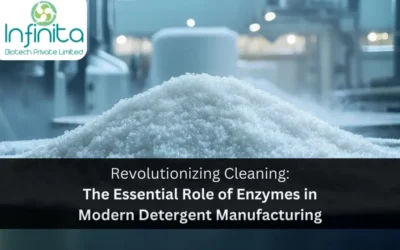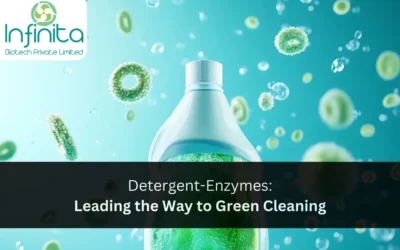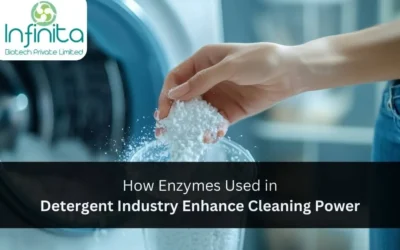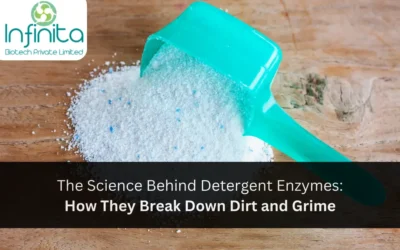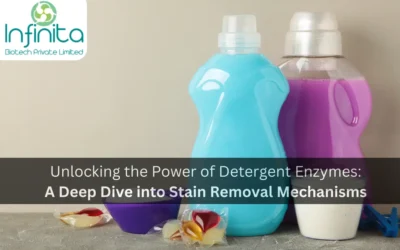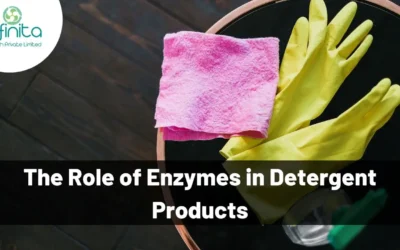Uses Of Protease Enzymes In Detergent Industry
Proteases, as also called peptidases or proteinases, are enzymes that perform proteolysis. Proteolysis is one in all the foremost necessary biological reactions. The proteolytic activity has been attributed to a category of enzymes known as protease enzyme. These enzymes square measure of wide distribution and they perform significant biological processes. Proteases have evolved to perform these reactions by numerous different mechanisms and different classes of protease can perform the same reaction by completely different catalytic mechanisms. Proteases are found in animals, plants, bacteria, archaea, and viruses. Proteases mechanism of action classifies them as either serine, cysteine or threonine proteases (amino-terminal nucleophile hydrolases), or as aspartic, metallo and glutamic proteases (with glutamic proteases being the only subtype not found in mammals so far).
Which Are The Functions Of Proteases?
Protease enzyme square measure concerned in several aspects of human biology. Other processes mediate by proteases embrace curdling, immune function, maturation of prohormones, bone formation, programmed cell death and the recycling of cellular proteins that are no longer needed.
Proteases conjointly supply a valuable target in several therapeutic settings, as well as presenile dementia, cancer, and viral infection. MMP-9, a matrix metallopeptidase, plays an important role in angiogenesis and is a therapeutic target for cancer. Because of their significance within the pathology of sickness, proteases square measure a relevant drug target category. Proteases activity are central to diverse physiological cascades throughout biology. Some are essential for coagulation, while others contribute to cancer pathology.
Proteases can be classified into seven broad groups:
- Serine proteases – using a serine alcohol, display a wide range of functions.
- Cysteine proteases – using a cysteine thiol, that include caspases which are involved in apoptosis and inflammation, and cathepsins which promote protein degradation.
- Threonine proteases – using a threonine secondary alcohol
- Aspartic proteases – using an aspartate carboxylic acid, that include beta and gamma secretases, the two enzymes necessary to release amyloid beta peptides from the Alzheimer’s disease associated amyloid precursor protein (APP).
- Glutamic proteases – using a glutamate carboxylic acid
- Metalloproteases – using a metal, usually zinc’ the Metalloprotease family includes aminopeptidases and endopeptidases, which are secreted, membrane-bound, or cytosolic.
- Asparagine peptide lyases – using an asparagine to perform an elimination reaction (not requiring water)
Proteases square measure one in all the foremost necessary business enzymes utilized in numerous industrial domains like detergent and animal skin industries. The alkaline protease enzyme, as well as other detergent-compatible enzymes such as lipases and amylase enzyme, serve now as the key components in detergent formulations. They break down various stains during fabric washing. The seek for detergent-compatible proteases with higher properties may be a continuous exercise. The current trend is to use detergent-compatible proteases that are stable over a wide temperature range. Although the proteases showing stability at elevated hydrogen ion concentration have the capability to be utilised in detergent formulations, their usage can be significant if they are also stable. The present review describes the detergent-compatible proteases tested as detergent additives.
Proteases As Laundry Detergent Additive
Protease Enzyme in detergent and laundry industry are used for over fifty years to facilitate the discharge of super molecule materials in stains like those of milk and blood. The super molecule dirt coagulates on the material within the absence of proteinases as a results of laundry conditions (Maurer, 2004). The enzymes take away not solely the plain stains, such as blood, but also other obvious materials including proteins from body secretion and food such as milk, egg, meat and fish. The quality of associate protein preparation to be used in detergents depends on its compatibility with the detergents at a hot temperature. An ideal detergent protein ought to be stable and active within the detergent answer and will have adequate temperature stability to be effective in an exceedingly wide selection of laundry temperatures.
The protease enzyme square measure one in all the quality ingredients of all types of detergents starting from those used for home washing to reagents used for improvement contact lenses or dentures. The preparation of the primary catalyst detergent Brunus dates back to 1913 and consisted of washing soda and a crude duct gland extract. The first detergent containing the microorganism protein was introduced in 1956 underneath the brand Bio-40. All major subtilisins for detergents are produced by Bacillus, because these species are able to secrete large amounts of extracellular enzymes.
Enzyme Detergent Granulation And Formulations
The use of enzymes in detergent formulations is presently common in developed countries, with over half of all detergents presently available containing enzymes. However, in today’s dynamic market, the most successful detergent brands combine proteases with other enzymes to deliver outstanding cleaning performance. In spite of the very fact, that the detergent industry is one of the largest markets for enzymes, details of the enzymes used and the ways in which they are used, have rarely been published by Graham. Other enzymes utilised in detergents embrace α-amylases, cellulases and lipases. A number of subtilisin variants square measure utilised in detergent worldwide with totally different trade names.
The zoom of detergents was quickly set back within the early 1970s, once employees in detergent factories developed allergies to the protein preparations. Enzyme manufacturers resolved this downside by developing dirt free peptidase formulations. Today, the enzyme preparations are marketed either as a stabilised enzyme solution or as encapsulated and coated granulates. The liquid preparations ordinarily have a reduced water content and contain important amounts of one,2-propanediol. Granulation processes makes the utilisation of extrusion, high shear mixing and fluidised beds. In developing dust-free granulates (about zero.5 metric linear unit in diameter), the catalyst is incorporated into associate inner core, containing inorganic salts (e.g., NaCl) and sugars as preservative, sure with reinforcing, fibres of carboxymethylcellulose or similar protective colloid. This core is coated with inert waxy materials made up of lamp oil or synthetic resin glycol and numerous deliquescent binders, which later disperse in the wash.
This combination of materials each prevents dirt formation and protects the enzymes against injury by alternative detergent parts throughout the storage. After release from granulated form, enzyme must withstand anionic and non-ionic detergents, soaps, oxidants such as sodium perborate which generate hydrogen peroxide, optical brighteners and various less-reactive materials, all at pH values between 8.0 and 10.5.
Detergent Gels:
Search for Novel Detergent Proteases
Until some years ago new enzymes for the detergent trade were isolated in classical manner by screening microorganisms in nature. Industrial strain improvement programs victimisation classical microbiological ways are dispensed over a few years and have resulted within the development of many extremely productive strains. This observe continues to be used nowadays for screening however new technologies viz, gene-splicing and super molecule engineering square measure dynamic the manner new enzymes square measure developed. Genetic engineering will facilitate to extend production yield and thereby open up new prospects. Enzymes from genetically built microorganisms square measure already within the market and therefore the variety can increase considerably within the future and this development can provide each a lot of stable and higher performing enzymes in the future. Protein-engineered enzymes entered the market at the start of the 1990s and established themselves as benchmarks in many applications.
All protease enzyme in detergent presently utilised in the market square measure amino acid proteases made by B strains. B. licheniformis is one of the predominant sources of alkaline proteases. The fungal alkaline proteases are advantageous due to the ease of downstream processing to prepare a microbe free enzyme. A base-forming proteolytic enzyme from Conidiobolus coronatus was found to be compatible with the business detergents utilized in Bharat and retained 43% of its activity at 50°C for 56 minutes within the presence of Ca2+ (25 mm) and glycine (1M). Other protease enzyme in detergent are isolated from Conidiobolus coronatus, B. licheniformis (Ward, 1983), B. stearothermophilus, B. thermoruber, Thermoactinomyces sp. HS682 and Bacillus sp.

